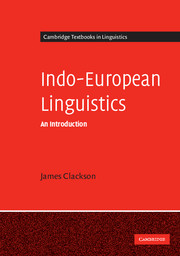Book contents
- Frontmatter
- Contents
- List of figures
- List of tables
- Preface
- Transliteration conventions
- 1 The Indo-European language family
- 2 Phonology
- 3 Morphophonology
- 4 Nominal morphology
- 5 Verbal morphology
- 6 Syntax
- 7 Lexicon and lexical semantics
- Glossary
- References
- Word index
- Language index
- Person index
- Subject index
6 - Syntax
Published online by Cambridge University Press: 05 June 2012
- Frontmatter
- Contents
- List of figures
- List of tables
- Preface
- Transliteration conventions
- 1 The Indo-European language family
- 2 Phonology
- 3 Morphophonology
- 4 Nominal morphology
- 5 Verbal morphology
- 6 Syntax
- 7 Lexicon and lexical semantics
- Glossary
- References
- Word index
- Language index
- Person index
- Subject index
Summary
Syntactic reconstruction
Diachronic syntax is where it's at.
(Campbell and Mithun 1980)To judge from the number of conferences, books and theses, diachronic syntax is still where it's at in the first decade of the twenty-first century, in IE studies as in the rest of historical linguistics. Despite this, recent introductions to IE linguistics either omit syntax altogether (Beekes (1995) and Szemerényi (1996)), or accord it much less discussion than morphological and phonological reconstruction (Meier-Brügger (2003) and Fortson (2004)). There is still much pessimism about how much of IE syntax can be reconstructed, exemplified by the words of Penney (2000: 35):
[I]t is not clear that any substantial reconstruction of syntactic patterns, with the exception perhaps of elements of word order, can be achieved without recourse to morphology, so that the study of the syntax of IE can appear to be essentially the study of the function of forms, and whether a theoretical linguist of today would accept this as an adequate approach to syntax must be open to doubt.
In this chapter we shall begin by asking why syntactic reconstruction is so difficult, and assess what syntactic reconstruction is possible and what is not. We shall then proceed in the remainder of the chapter to examine areas of current debate in IE syntactic studies.
Although the early comparativists were not uninterested in syntax, most accounts of the history of IE syntax begin with Berthold Delbrück (1842–1922), particularly with his three-volume work on comparative syntax (Delbrück 1893–1900), which is still frequently described as ‘unsurpassed’.
- Type
- Chapter
- Information
- Indo-European LinguisticsAn Introduction, pp. 157 - 186Publisher: Cambridge University PressPrint publication year: 2007

